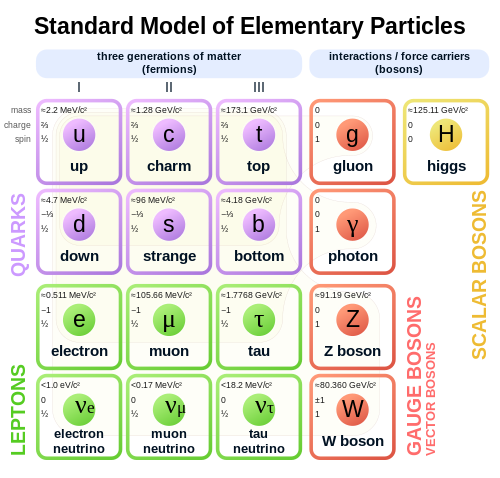India-based Neutrino Observatory – An Interesting project initiated by GOI

Image: MissMJ. Published under this creative commons license.
Don’t be afraid of the above diagram. I don’t understand anything in that as well. It’s been published here for aesthetic/design purpose 🙂 In our science classes we were taught about atoms, remember? Most objects are made of millions/billions of small atoms. We also studied about the structure of an atom: Electrons orbiting around the nucleus and the nucleus containing protons and neutrons.
For a while, people thought atoms were the fundamental particles of this universe. Later on, this was disproved. According to the standard model of particle physics, the 16 particles shown above are now considered as the fundamental particles of the universe. Well, at least until someone discovers something smaller than that!As you can see in the above diagram (3rd row from the top), three green boxes show three types of neutrinos – Electron neutrino, Muon neutrino and Tau neutrino.
But what are these neutrinos? For one, they are considered to be one of the fundamental particles of the universe. That means, they are very tiny (for an analogy, you can think of neutrinos being similar to electrons/protons but they are not found inside an atom).
Neutrinos are found in abundance in the universe and are in fact the second most abundant particle after protons (light). They are generated as a result of nuclear reactions (in stars), supernova explosions, interaction of cosmic rays with our atmosphere, etc. Many neutrinos are generated from our sun. You maybe surprised to know that 65 billion solar neutrinos pass through every square cm of the earth per second. Whoa!
Why then aren’t we hit by them? For one, they are so tiny and second, they do not interact with any matter around them. That means, they can pass through almost anything (including the earth or anything else) without causing any reaction or without becoming a disturbance! They are mostly transparent to matter. Well, Almost.
People thought that neutrinos were massless and travel at the speed of light. Now they think that neutrinos might have a tiny mass and travel almost at the speed of light. Neutrinos are charge-neutral and there are anti-neutrino particles as well! The problem with neutrinos is, though we know that they exist, we don’t know any of their properties.
The LHC (Large Hardon Collider) project seeks to (among other experiments) identify another basic particle – Higgs Boson. In its case, we don’t know whether the Higgs Boson exists or not. It has only been proposed theoretically.
The INO (India-based Neutrino Observatory), on the other hand, will be used to detect neutrinos (which we know exists) and study their properties. Even though neutrinos do not interact with matter, a very small percentage of them (that contain a slightly higher charge) do interact and cause a feeble reaction.
The INO will have a large static detector built below a hill (as neutrinos cannot be detected on the surface of the earth due to the large influx of cosmic rays) and will be used to detect and study neutrinos produced by interaction of cosmic rays with our atmosphere. The detector is similar to a telescope (but is made up of large magnets) and will observe the neutrinos passing through them. There are other experiments being carried out in other countries that study neutrinos emitted from sun, stars, etc.
But why detect neutrinos? Since neutrinos are the only particles that can pass through almost anything, neutrinos can be used to study the composition of earth’s core and sun’s core. Neutrinos coming from various parts of the universe (supernova, core of milky way, stars, etc.) can be used to understand more about these cosmic phenomena. It is possible to artificially create neutrinos (through nuclear fission, for example) or study neutrinos emitted by existing nuclear reactors to prevent nuclear proliferation. Once we are able to detect them and study them, applications are innumerable.
The INO project is coordinated by various institutions including the Tata Institute of Fundamental Research, IIT’s and various academic bodies in India. Even the detector, it seems, has been designed indigenously. This project will house the largest magnet on the earth. It was Tata Institute of Fundamental Research (along with few more universities) that first recorded the cosmic ray neutrino interaction in Kolar Gold fields in 1965.
Destination Infinity
To know more about the INO project, visit their information page.
To know more about Neutrinos, visit the Wikipedia page for Neutrino.
Disclaimer: I am not any expert on neutrinos and hence there is no guarantee that the above article is accurate. It is only based on my understanding.

Nice information
Yeah, its good to know that the GOI is conducting some basic science experiments. These initiatives will give an opportunity for many local scientists/engineers to work on basic science research projects…
Destination Infinity
Looks like nice information. To tell the truth, me and science are far apart. I like to travel by plane. But I cannot learn how the plane works.
Even me and science are far apart as well. I can only provide a basic overview of things. Ask me to go deeper, and I am lost.
Destination Infinity
Thanks for the detailed description on Neutrinos. I know little about particles exist but u post adds more info. I think INO’s talk was there for long and on seeking a best place for conducting the research.
Yes, the proposal has been going around for a long time. Now they have identified a place near Theni, TN and hope to start the construction works soon.
Destination Infinity
Very informative!
informative post
oh boy .. that is a lot of infor.. especially for the likes of me who are not intelligent 🙂
Informative one…
i wish i was sheldon cooper from big bang theory to raise some questions regarding this information..lol 😛
very informative indeed…!
A little over head transmission for me but nonetheless interesting.